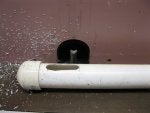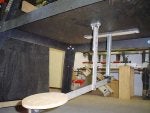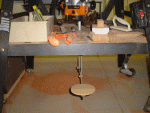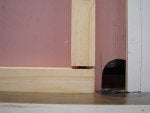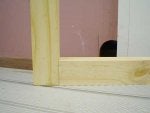I have a piece of 1-1/2 inch PVC pipe that I need to cut a pair of matching parallel slots about 10 to 11 inches long and 1/2 inch wide in. One 1/2 inch channel per side on opposite sides. I'm wondering if there is a safe way to do this on the router table.
What I'm doing is building a rudder for a small plastic boat using the pipe as the shaft and a plastic cutting board as the rudder itself. Totally waterproof. The board is 1/2 inch thick. I want to "split" one end of the pipe lengthwise about 10 or 11 inches and insert the board between the two halves, and then bolt it in place with predrilled holes drilled in the pipe prior to making the cut.
I have had several ideas for making the cut. All involve clamping the pipe into a jig to prevent it from rotating or moving, drill a 1/2 inch hole all the way through the pipe at the end of the proposed slot location, and then push the pipe through:
(a.) the tablesaw four times, cut once, flip and cut again, then move fence 1/2 inch and repeat.
(b.) the router table using a 1/2 inch bit, cut once, flip and cut again, or (and this scares me to death) use a 1/2 inch bit tall enough to span the pipe and cut both slots at once (this one I think I'll skip).
(c.) the bandsaw, use a fence and cut once, move fence 1/2 inch and cut again. The trouble is I have seen my blade drift in straight cuts and haven't yet worked this out. I know I should but just haven't yet. I'd rather go fishing 😁 but I need a boat rudder first. 😂
What I'm doing is building a rudder for a small plastic boat using the pipe as the shaft and a plastic cutting board as the rudder itself. Totally waterproof. The board is 1/2 inch thick. I want to "split" one end of the pipe lengthwise about 10 or 11 inches and insert the board between the two halves, and then bolt it in place with predrilled holes drilled in the pipe prior to making the cut.
I have had several ideas for making the cut. All involve clamping the pipe into a jig to prevent it from rotating or moving, drill a 1/2 inch hole all the way through the pipe at the end of the proposed slot location, and then push the pipe through:
(a.) the tablesaw four times, cut once, flip and cut again, then move fence 1/2 inch and repeat.
(b.) the router table using a 1/2 inch bit, cut once, flip and cut again, or (and this scares me to death) use a 1/2 inch bit tall enough to span the pipe and cut both slots at once (this one I think I'll skip).
(c.) the bandsaw, use a fence and cut once, move fence 1/2 inch and cut again. The trouble is I have seen my blade drift in straight cuts and haven't yet worked this out. I know I should but just haven't yet. I'd rather go fishing 😁 but I need a boat rudder first. 😂



